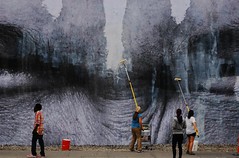 Scott Lynch
Scott LynchGood morning, East Village.
Sure enough, the Astor cube got stripped of its sweater yesterday. Luckily its installation was videotaped for posterity so we can remember the Alamo in crocheted form – Bowery Boogie has the footage.
On Untapped New York, “Downtown Doodler” Bernadette Moke goes on an Urban Design Week tour of the Bowery and offers up a history of the buildings complete with sketches.
Elsewhere on the Bowery, EV Grieve finds an online listing of crooner John Legend’s apartment at East Fourth Street. Amenities include a “landscaped building entrance, parking garage, roof deck and an exterior spa-swimming pool.” Read more…
 Phillip Kalantzis-Cope
Phillip Kalantzis-Cope Good morning, East Village.
City Room profiles Larry Fagin, a poet and teacher who, at the age of 74, is “one of the East Village’s last standing bohemians.” He lives in a two-bedroom walk-up in Allen Ginsberg’s old building. His rent has almost tripled since he took the apartment in 1968 – yet he’s still paying only $150 a month.
EV Grieve notes that the Upright Citizens Brigade has opened its outpost on East 3rd Street, complete with Hot Chicks Room.
Thought Delancey was a bad street to bike on? Brooklyn Spoke thinks the Bowery is also a “death-trap” for bikers, and believes there has been “too much focus on what’s happening on the Manhattan Bridge and not enough on what’s happening when cyclists get off of it.” Read more…
The eagle-eyed EV Grieve noticed construction plans for a 7-Eleven convenience store inside the window of 351 Bowery – another sign of the onetime hardscrabble strip’s increasingly “suburban feel.” Gothamist confirmed that the store is expected to open on October 5.
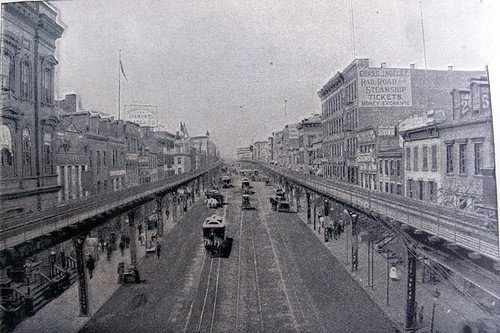 NYPL The Bowery in 1895.
NYPL The Bowery in 1895.Lately, the Bowery has started to look more like Dubai and a whole lot less like a poor man’s Broadway. But for at least three hours on Sunday, old-time songs will echo on the street once again, as a connoisseur of vaudeville songs and a historian lead a walking tour of music from the Bowery’s heyday. Bree Benton, accompanied by a viola and accordion, will sing songs like “My Brudda Sylvest,” and “Yiddle On Your Fiddle, Play Some Ragtime” (which was written by one of the former Lower East Side’s most famous sons, Irving Berlin.)
“The songs are so full of life, they really speak to the people — the common people,” said Ms. Benton, who will play the character of Poor Baby Bree, a down-and-out kid from the Lower East Side. “People who couldn’t afford to be entertained on Broadway; they went to the Bowery.” Read more…
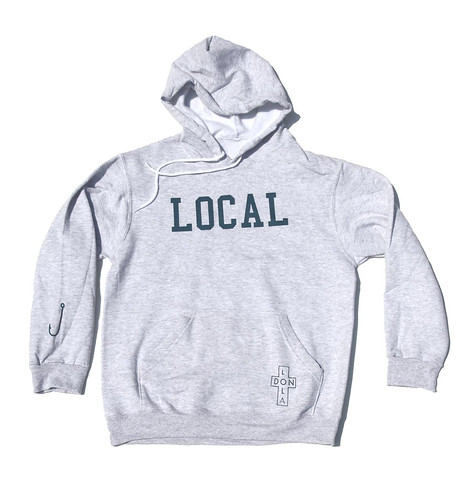 Courtesy of Lola No relation to The Local.
Courtesy of Lola No relation to The Local.Last week, James Cruickshank, the owner of Whitmans on East Ninth Street, threw a party relaunching Lola, the apparel company he runs with elementary-school buddy Emmett Shine. The duo started the line in their late teens (both are now 27) but recently put it on hiatus so that Mr. Cruickshank could devote time to opening his restaurant, and so that Mr. Shine could focus on Gin Lane Media, the branding and design company he runs, along with Lola, out of 263 Bowery.
“Every single day we received e-mails from people around the world asking us when we were going to relaunch,” said Mr. Shine. Read more…
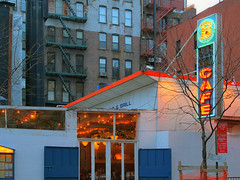 Joel RaskinB Bar and Grill, 40 East Fourth Street.
Joel RaskinB Bar and Grill, 40 East Fourth Street.When I sat down the other day to have lunch in the garden courtyard of B Bar and Grill, at 40 East Fourth Street, I did the natural thing. I took a seat facing out towards the Bowery. But then I thought: Why am I looking at traffic when I could be looking at the garden? And so I turned my back on the street.
Here is what I saw: A light breeze stirred the branches of the six great, spreading locust trees which grow inside the courtyard. Straw baskets, some as big and broad as beehives and others the size and shape of Chinese lanterns, hang from the branches, and the breeze had set them in gentle, bobbing motion. It was a warm day, but the broad leaves filtered out the sunlight and cast dappled shapes on the brick floor. The garden is enormous — a 3,000-square-foot space where a gas station once stood — and the sounds of talk and clattering silverware drifted up towards the sky. The East Village is not a serene place; but B Bar is.
There is a very complex, and very charming, interplay between “indoors” and “outdoors” at B Bar. Only one half of the roof is open to the sky; the other half is covered by a bamboo trellis, which leaves stripes rather than blotches of sunlight on the brick tile of the ground — that is, floor; no, ground. The surrounding wall is pierced by wide openings which offer prospects of Fourth Street and the Bowery. At B Bar you are embowered, but your beloved street-world is very much with you. Step through the wall, and you’re there.
Read more…
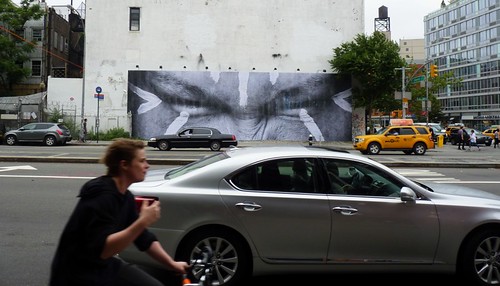 Michael Natale
Michael Natale 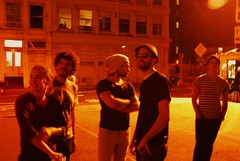 Tim Schreier
Tim SchreierGood morning, East Village.
Another major overhaul took place Thursday at the corner of Bowery and East Houston. A new face, pictured above, has replaced the colorful ghouls painted by artist Kenny Scharf on the Tony Goldman graffiti wall; EV Grieve says it’s called, “Lakota, North Dakota.” Community contributor Tim Schreier shared photos of the work in progress at right.
Local theatergoers will have their last chance to visit Performance Space 122 this Saturday before the venue on the corner of First Avenue and Ninth Street temporarily closes for renovations. Theater Mania reports that the organization — named for the old Public School 122 building it has inhabited since 1979 — will relocate until construction is complete.
Counter will also soon be gone. The vegetarian bar and bistro on First Avenue between Sixth and Seventh Streets told Gothamist that its closing is imminent, although owner Deborah Gavito has yet to give an exact date.
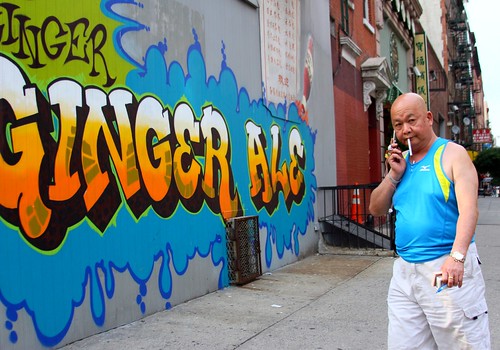 Michelle Rick
Michelle Rick Good morning, East Village
The sounds of the citywide free festival Make Music New York could be heard in the East Village yesterday. The Village Beat found a small outdoor concert in Astor Place, hosted by the local live performance venue, Joe’s Pub.
The performance artist Liu Bolin camouflaged himself into the Kenny Scharf mural yesterday near the intersection of Houston Street and Bowery. The Wooster Collective shared photos of the wall’s transformation.
But more outdoor art might be put on hold this week; The Weather Channel predicts several days of off and on thunderstorms, making the jump into summer a wet one.
Ronald Sosinski, 62, is the director of The Proposition art gallery at 2 Extra Place and an East Village resident for more than 20 years. He and his business partner, Ellen Donahue, opened E.M. Donahue Gallery for Contemporary Art on East 11th Street between Avenues A and B in 1985 and followed the art scene to SoHo in 1987 and to Chelsea in 2002, where the space was renamed The Proposition. After more than 20 years away from the East Village, Mr. Sosinski and Ms. Donahue reopened the gallery on Extra Place (First Street just off of Bowery) in 2010. Mr. Sosinski discusses The Proposition’s current show and the gallery’s new location.
NYU Journalism’s Mark Riffee reports.
“A Step Back into the Future” is on display until May 1. The show features mid-20th century furniture by James Mont, custom wallpaper by Este Lewis, and a sculpture by Mickalene Thomas.
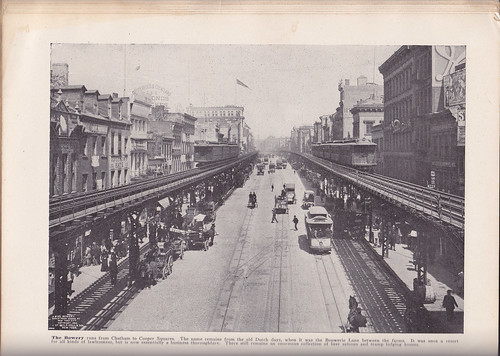 Courtesy of Tim SchreierA photograph of The Bowery in the 19th century showing the elevated railroads.
Courtesy of Tim SchreierA photograph of The Bowery in the 19th century showing the elevated railroads.Kerri Culhane’s lightning-speed, three-minute presentation at the Community Board 2 meeting held at Our Lady of Pompeii Church on Monday provided little indication of the vast research she has gathered in seeking to create a Bowery National Historic District which would span the approximately mile-long avenue, which runs from Chatham Square to Cooper Square .
Currently, individual buildings on the Bowery including The Bowery Savings Bank and Bouwerie Lane Theater have been designated National Historic Landmarks, along with limited portions of the Bowery being included in already designated National Historic Districts. The effort is being co-sponsored by the Bowery Alliance of Neighbors and The Two Bridges Neighborhood Council.
Former NYC Landmarks Preservation Commissioner Anthony Tung has described the “disjointed beauty” of the assemblage of buildings which line the former Native American foot path and later road leading to Peter Stuyvesant’s farm or “bouwerie” from which the street took its name.
Read more…
 Clockwise from top left: (1.) Bowery Elevated Train, circa 1896; (2.) Bowery near Bleecker, circa 1915; (3.) 35 Cooper Square in February this year; (4.) Boys on the Bowery selling chewing gum, 1910; (5.) A Union enlistee of the New York 86th Regiment and his betrothed, circa 1861. All images courtesy Library of Congress, except (3.) lower right, photo illustration by Tim Milk
Clockwise from top left: (1.) Bowery Elevated Train, circa 1896; (2.) Bowery near Bleecker, circa 1915; (3.) 35 Cooper Square in February this year; (4.) Boys on the Bowery selling chewing gum, 1910; (5.) A Union enlistee of the New York 86th Regiment and his betrothed, circa 1861. All images courtesy Library of Congress, except (3.) lower right, photo illustration by Tim MilkLocal historian Tim Milk recalls dark episodes which never quite extinguished the charm of 35 Cooper Square.
They could hardly believe the fellow, wanting to go back to his regiment. Especially considering what he had seen: the rout of the Union at the bloody battle of Bull Run. There, the heroic Lieutenant John S. Whyte, who had refused to leave his wounded commander, fell into Confederate hands. But in a recent prisoner of war exchange, he was returned home to his kith and kin in New York.
But he did not wish to retire with honors. Indeed, he was keen to “return to the fight,” he said.
And so his pals shook their heads and dragged him down to the Marshall House, a tavern at 391 Bowery, an address we know today as 35 Cooper Square. There they presented him with a sword and a sash in an affair both touching and festive. After a grand hurrah, the champagne flowed like a river long into that night of March the 21st, 1862.
This I found in the archives of the New York Times, in a curious walk down that ancient lane, the Bowery. From out of each door came someone with a tale to tell which, except for these old papers, and poor relics like 35 Cooper Square, would otherwise have vanished, lost in time.
“Time,” Stephen Hawking once said, “…whatever that is.” Even he doesn’t pretend to know. As the so-called future, it is but a mere concept. As the past, it holds everything that has ever happened, and leads all the way back to eternity. There it washes up on distant shores for no apparent reason, except perhaps for our return. Read more…
 Kathryn Kattalia
Kathryn KattaliaDuring the 20 years that she has lived on East Fourth Street, Frances Bush has seen dozens of accidents involving pedestrians rushing across the Bowery — a wide avenue stretching roughly a mile from Chatham Square in Chinatown to Cooper Square in the East Village.
“You have cars coming off of Houston onto Bowery and they’re going quite rapidly,” said Ms. Bush, 50. “With the construction and the bike lanes, people get confused. A lot of safety has to do with that.”
With traffic running north and south, the Bowery is one of the main arteries of the East Village. It is also one of the deadliest.
Of the 109 pedestrians hit and killed on Manhattan’s streets between 2007 and 2009, seven fatalities took place on the Bowery, making it the fourth most dangerous road for pedestrians in the borough, according to a newly released report by the Tri-State Transportation Campaign.
For a longtime Bowery observer like Ms. Bush, that comes as no surprise.
“People don’t abide by the law,” she said. “They don’t follow the lights, they don’t follow directions. It gets real crowded here and people get distracted.”
Read more…
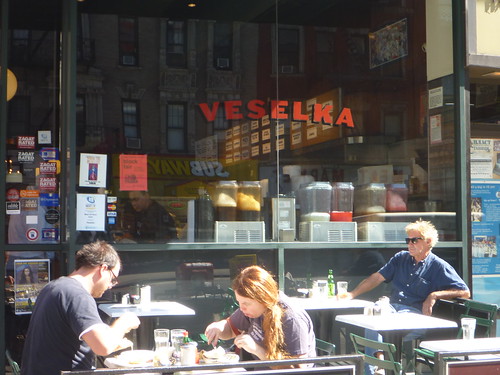 Hannah Rubenstein The owners of the iconic Ukrainian restaurant Veselka are planning a new restaurant on the Bowery.
Hannah Rubenstein The owners of the iconic Ukrainian restaurant Veselka are planning a new restaurant on the Bowery.In a few months there will be a new Veselka Restaurant on the Bowery. Whispers about construction on a Second Avenue subway line prompted Tom Birchard, owner of the iconic East Village Ukrainian restaurant, to take out an unconventional “insurance policy” on his investment: Nine blocks south, in the same building as DBGB Kitchen & Bar, Veselka Bowery is taking shape behind closed doors.
The second Veselka, located on Bowery and First Street, won’t be a carbon-copy of the original — Mr. Birchard said that he hopes the new restaurant will allow him to explore Ukrainian food “at a slightly higher level.” Mr. Birchard’s son Jason will take over the day-to-day operation of the original location at 144 Second Avenue.
The owners of Veselka already operate a café, Little Veselka, near East First Street and First Avenue, which essentially features an abridged version of the Veselka menu — coffee, sandwiches, breakfast food. But Veselka Bowery will be its own restaurant with an entirely different menu and a plan to serve alcohol.
Read more…
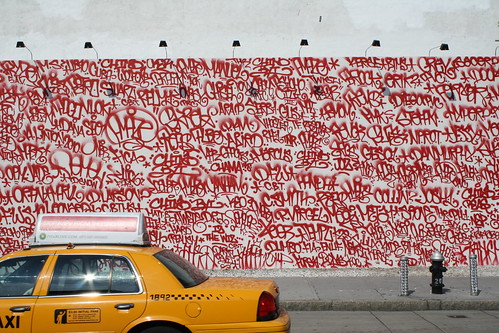 Kelly Knaub The wall at Bowery and Houston.
Kelly Knaub The wall at Bowery and Houston.Two new curators hope that the large piece of “extreme tagging” on the cement wall at Bowery and Houston will quell concerns about over-sized street art from some members of the community.
Produced by San Francisco painter and graffiti artist Barry McGee, the wall is a collage of simple but striking tags, referring by name and writing style to various intergenerational graffiti artists.
Mr. McGee’s work is the fourth formally curated project at Bowery and Houston since May 2008, and the first for the space’s new curators: 29-year-old East Village residents Kathy Grayson and Meghan Coleman, both alumni of now defunct Deitch Projects.
“Barry McGee is the ultimate smoother over,” Ms. Grayson said, explaining her hope that Mr. McGee’s mural would “smooth over the Shepard Fairey mess,” referring to the previous, controversial mural. (For a comprehensive play-by-play of destruction to the Fairey mural, which lived from April to August, see here via Bowery Boogie and here via ArtsBeat.)
Read more…









